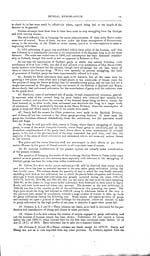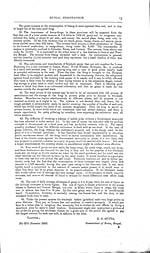Medicine - Drugs > Report of the Indian Hemp Drugs Commission, 1894-1895 > Volume III
(16) Volume 3, Page 12
Thumbnail gallery: Grid view | List view

12 REPORT OF THE INDIAN HEMP DRUGS COMMISSION, 1893-94. [APP.
Paragraph 80, Excise
Report, 1878-
79.
Paragraph 96, Excise
Report, 1878-
79.
Board's Excise
Administration Report for the year 1878-79, from which extracts are
given
below, that ganja was actually imported during that year from
Bombay and the Central
Provinces:—
"During the year under
report 10 maunds of flat choor ganja were for the first
time
imported into Calcutta from
Bombay under a pass granted
by the Excise Superintendent. The Commissioner states
that the Bombay drug, though good-looking, is less narcotic
than Rajshahi ganja, and has not therefore come into much repute on
this side of India."
As regards the Nimar ganja imported, it is stated as
follows:—
"In consequence of short
supply of ganja from Rajshahi, 8 maunds of Nimar ganja
were imported into Monghyr
from the Central Provinces
and 32 maunds 34 seers of the same description of ganja
were brought into Shahabad by a dealer. Of the latter
quantity, 17 maunds 25 seers were sold locally, and the balance at
Monghyr. The ganja
produced in Nimar is inferior in quality to Rajshahi ganja, and
does not meet with ready
sale. Its wholesale price is cheap. On importation into Bengal, it
is dealt with like Raj-
shahi ganja, and duty on it is levied at the rate of Rs. 4 per
seer."
Vide paragraph 101 of the Excise
Report for 1880-81.
54 Column 10.—No
information as regards the quantity of charas imported can
be
furnished prior to the year
1880-81, when a duty of Rs. 8
per seer was for the first time imposed on this drug under
Government order No. 3347, dated the 25th October 1880.
Before this year charas used to be imported free, and apparently no
account of the quantity
imported was kept. This remark also applies to the figures in
columns 33 and 43.
55. Column
13.—Complete information for this column is not available. The
figures for
the first four years show only exports to the North-Western
Provinces, as exports to other
places were not separately shown in the reports of those years.
Similarly, the figures for
some succeeding years represent exports to North-Western Provinces
and Assam only. The
figures for the last few years only represent the quantities
exported to North-Western Pro-
vinces, Assam, Kuch Bihar, and Nepal.
56. Columns 14 to 16.—No information.
57.
Columns 17 to 21.—Wholesale vendors who are the
goladars pay no license fees,
and their number is not reported.
58.
Columns 22 to 26.—It will be observed that the number
of licenses for the retail sale
of ganja, charas, and majum has fallen off appreciably, while there
has been very little fluc-
tuation in the number of licenses issued for the retail sale of
bhang. The number of ganja
retail licenses issued in 1873-74 was 4,398, while 2,672 licenses
only were issued in 1892-93,
the average license fee being Rs. 55 and Rs. 413 respectively. The
largest reduction in
number was made in 1875-76: since then there have been considerable
fluctuations, but the
object steadily aimed at has been to keep the number down as much
as possible.
59.
Columns 27 to 31.—In spite of the great falling off in
the number of licenses, the
revenue from license fees has remarkably expanded—that from ganja
licenses from 2½ lakhs
of rupees to 11 lakhs, that from charas licenses from Rs. 3,000 to
Rs. 5,000, and that from
bhang licenses from Rs. 13,000 to Rs. 33,000. The fees derived from
majum licenses, how-
ever, show no improvement, but rather a slight decrease owing
doubtless to a falling de-
mand. The total license fees show an increase of nearly 9 lakhs of
rupees, or 340 per cent.
The great increase in
ganja license fees in 1875-76 and subsequent years was due to
the
introduction of the auction system and to keen competition at the
time of settlement. In
recent years much care has been bestowed in fixing the upset fee of
each shop, so as not to
leave everything to the chances of auction.
The sudden increase of
revenue on account of license fees for charas shops in
1880-81
was owing chiefly to the better settlement of shops in Calcutta on
account of an increased
demand for the drug, and to the opening of 14 new shops in the
district of Shahabad. It
will be seen that the imposition of a duty of Rs. 8 per seer in
1880-81 seriously affected the
total revenue: it decreased till the year 1884-85, from which time
there was a slow, though
steady, increase till 1889-90, followed by a rapid rise in the past
three years.
The rate of duty on ganja
has been several times enhanced since the year 1873-74,
and this with the augmented license fees has caused a decrease in
consumption from 8,125
maunds in 1873-74 to 5,451 maunds in 1892-93; but the duty receipts
have risen from
Rs. 8,36,355 in 1873-74 to Rs. 12,80,631 in 1892-93. The great
increase under the head of
license fees has already been noticed. It is satisfactory to note
that though the consump-
tion of ganja has been reduced in 20 years by nearly one-third, the
total revenue has during
the same period been more than doubled. The taxation on each seer
of ganja was represented
in 1873-74 by license fee Rs. .7 plus duty Rs. 2.5 = Rs. 3.2, while
the figures for 1892-93 are
—license fee Rs. 5 plus duty Rs. 5.8 = Rs. 10.8, or a rise of more
than 3½ times. In view of
the above facts it may be justly claimed for the department that
the administration of excise
on ganja has fully realized the principle of a maximum of revenue
with a minimum of con-
sumption.
The consumption of charas
shows a large increase, though the quantity is still small,
and it will be necessary ere long to raise the duty on it. The rate
is the same as for choor
ganja, while the proportion of narcotic matter is much larger in
charas.
Set display mode to: Large image | Zoom image | Transcription
Images and transcriptions on this page, including medium image downloads, may be used under the Creative Commons Attribution 4.0 International Licence unless otherwise stated. ![]()
| India Papers > Medicine - Drugs > Report of the Indian Hemp Drugs Commission, 1894-1895 > Volume III > (16) Volume 3, Page 12 |
|---|
| Permanent URL | https://digital.nls.uk/74551742 |
|---|---|
| Description | Bengal memorandum, cont. |
| Description | Volume 3: Appendices. Miscellaneous. |
|---|---|
| Attribution and copyright: |
|




